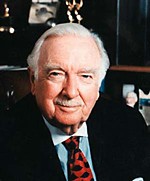Eye on an Icon
A new exhibit explores Walter Cronkite's life and legacy
By Belinda Acosta, Fri., May 28, 2010

For those who have grown up with the histrionics of talk radio and the bombastic delivery of some 24-hour cable news networks, former TV newscaster Walter Cronkite may seem like a throwback to another era. He is. Broadcast at a time when there were only three major TV networks, Cronkite's nightly newscast brought some of the last century's most awful news into U.S. living rooms. For many, his distinctive voice and grandfatherly delivery tempered the chaos, making him "the most trusted man in America." Now, nearly a year after his death, Cronkite's life and work are the subjects of the first exhibit dedicated to the respected journalist at the LBJ Library & Museum at the University of Texas at Austin.
The exhibit features materials from the holdings of the News Media History Archive of the Dolph Briscoe Center for American History. The archive was launched by the center's executive director, Don Carleton, in 1988. The Cronkite Papers marked the first acquisition for the archives, which would grow to become one of the most respected collections dedicated to the history of television and newspaper journalism, and Cronkite maintained a relationship with Carleton and the Briscoe Center until his death at the age of 92.
The Cronkite Papers cover the years from 1932 to 2007, shedding light on both Cronkite's personal life and a career that spanned five decades, during which he covered some of the most important events in history, including D-Day during World War II, the Nuremberg Trials, the assassination of John F. Kennedy, the civil rights movement, the Vietnam War, the Watergate scandal, and the space exploration program leading up to the first U.S. landing on the moon.
Chronologically organized, the exhibit features large-format photographs, multiple video screens, personal artifacts – letters, notes, journals, clothing – and other ephemera elegantly organized by award-winning exhibit coordinators, the design firm Riggs Ward. Cronkite's childhood days in Houston are noted, as are his days as a student reporter for The Daily Texan at the University of Texas at Austin. As a young man, he worked for United Press wire service covering World War II, but the majority of the Cronkite holdings cover his days as anchor and managing editor of The CBS Evening News.
Alongside his visual biography are timelines of world events, candid quotes, and rarely seen photographs of Cronkite with world leaders like Fidel Castro. What becomes quickly evident in various Cronkite quotes peppered throughout the exhibit is his self-effacing personality. While he was a "star" by today's standards, he was the last one to rest on his celebrity.
"I was just plain old lucky to be in the right place at the right time," he said to Playboy magazine in a June 1973 interview. "But I think that to take advantage of luck, you've got to have some ability to do the job. As far as the ability to work on camera is concerned, that part of it was an absolute accident. I never trained for it; I'm just lucky to have it. Whatever it is, it seems to work."
"Cronkite: Eyewitness to a Century" is on view now through Jan. 3, 2011, at the LBJ Library & Museum (2313 Red River). The exhibit is free and open to the public. For hours and more information, go to www.cronkiteexhibit.com.












